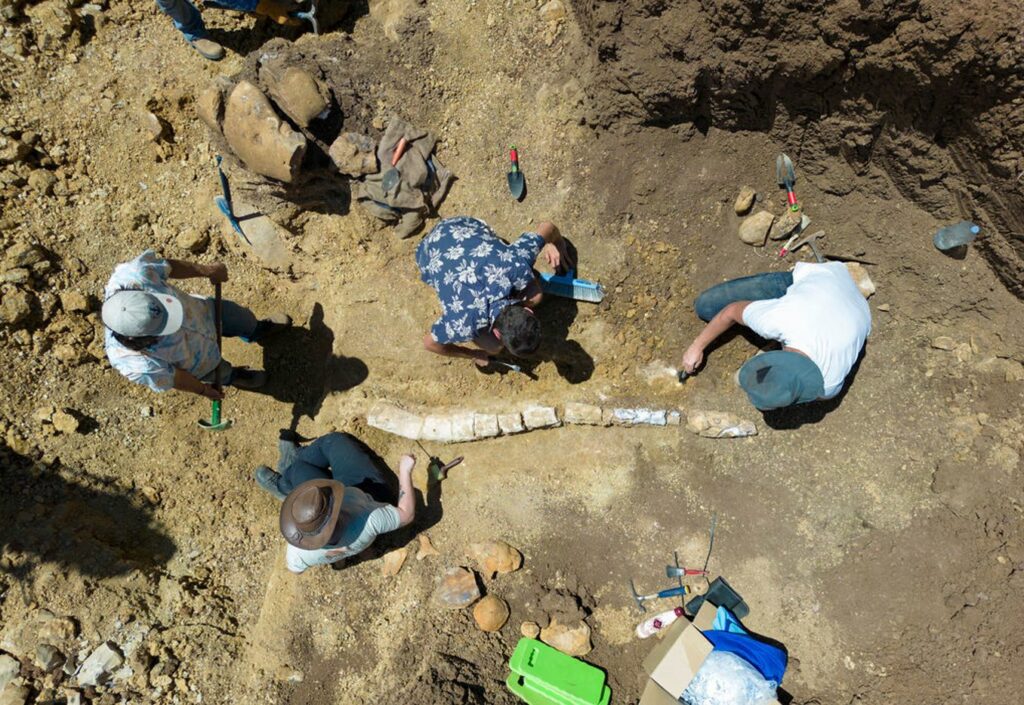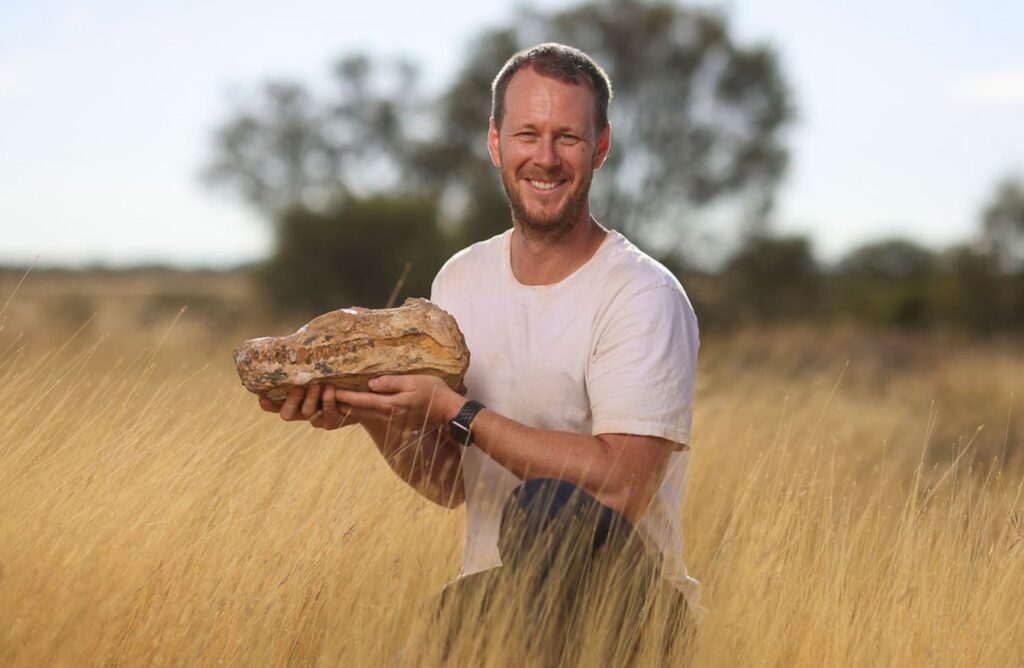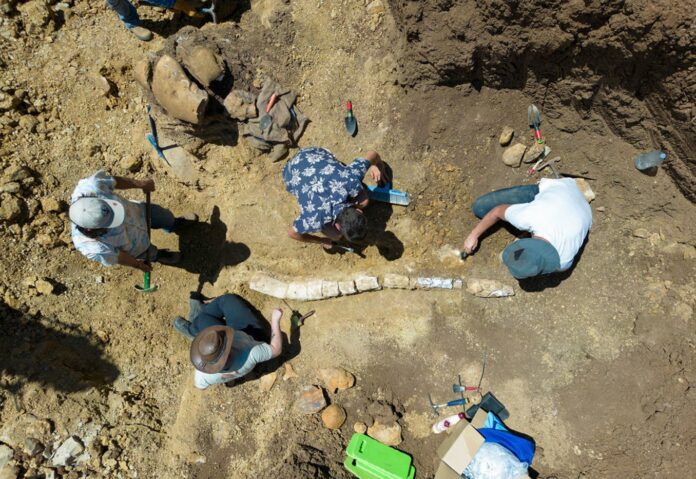Researchers were “extremely excited” when they saw this new fossil of Plesiosaurs – “it is like the Rosetta Stone of marine palaeontology as it may hold the key to unravelling the diversity and evolution of long-necked plesiosaurs in Cretaceous Australia.”
In what has been dubbed the “Rosetta Stone of marine reptile palaeontology,” palaeontologists from the Queensland Museum Network have discovered the first head and an associated body of a 100-million-year-old long-necked sea creature in Australia.
The uncommon fossil was found by Cassandra, a Western Queensland station owner who, together with her friends Sally and Cynthia, make up the “Rock Chicks” fossil-hunting group.
Palaeontologists from a museum recently went to the remote site to get a fossil of an elasmosaur, which was a plesiosaur that lived at the same time as dinosaurs.
Dr. Espen Knutsen, who led the field trip for the Queensland Museum Network as Senior Scientist and Curator of Palaeontology, said that this would be the first known head and body of an Australian elasmosaur to be in a museum collection.
“We were extremely excited when we saw this fossil – it is like the Rosetta Stone of marine palaeontology as it may hold the key to unravelling the diversity and evolution of long-necked plesiosaurs in Cretaceous Australia,” Dr. Knutsen adds.

“We have never found a body and a head together and this could hold the key to future research in this field.
“Because these plesiosaurs were two-thirds neck, often the head would be separated from the body after death, which makes it very hard to find a fossil preserving both together, so we are using CT scanning to give us an insight into these magnificent animals.”

Project DIG, a partnership between Queensland Museum Network, BHP, and BMA, helps Dr. Knutsen’s research on Cretaceous marine reptiles of Queensland. The goal of Project DIG is to make the collection’s knowledge available to people all over the world.
A large portion of Queensland was submerged under the Eromanga Sea during the early Cretaceous era (between 145.5 and 65.5 mya), and fossilized relics of the ocean’s occupants, including marine reptiles like plesiosaurs and ichthyosaurs, are often discovered all across the state.
In order to address issues about their origins and ecologies, these new specimens and current analytical techniques will assist in lifting the curtain on their ancient lifestyles.
Leeanne Enoch, Queensland’s Minister for the Arts, said that unique and historic fossils are still being found in the state’s remote areas. These fossils help tell stories about our world from 100 million years ago.
“Congratulations to Dr Knutsen, his team and the Queensland Museum Network for uncovering a globally significant palaeontological discovery of an almost complete elasmosaurus which is now located at its new home at the Museum of Tropical Queensland in Townsville,” says Minister Enoch.
“The Queensland Government supports the Queensland Museum Network in its enthusiasm to bring to light new stories, and the recent selection of the museum’s Muttaburrasaurus as our State’s fossil emblem proves the enduring popularity of dinosaur narratives among so many Queenslanders.
“As an important keeping place for over 15 million cultural objects and natural history specimens, the Queensland Museum Network not only plays an integral role in driving innovations in science but its collections, research items and exhibitions are essential to preserving our history to help prepare future generations.
“As we lead up to the 2032 Olympic and Paralympic Games, important discoveries like this Plesiosaur, profile Queensland Museum’s reputation, research and recognition on the global stage,” Ms. Enoch adds.
This discovery, according to Queensland Museum Network CEO Dr. Jim Thompson, will help Dr. Knutsen and his colleagues develop a complete picture of Queensland’s Cretaceous sea reptiles.
“We now hold the only head and body of an Australian elasmosaur in the world, and this significant find will contribute greatly to vital research into Queensland’s Cretaceous past,” Dr. Thompson points out.
“Queensland Museum Network holds one of Australia’s most complete plesiosaur specimens, nicknamed ‘Dave the Plesiosaur’, which was discovered in 1999, however despite having 80 per cent of its bones, it was missing a head, fins and tail tips.
“Through Project DIG, CT scans and 3D models will help us interpret data and potentially describe a new species.”
This new fossil could help solve the mystery of how Australian plesiosaurs lived and died.
Along with the new skeleton, many ichthyosaurs and plesiosaurs were also found and gathered on the field trip. These specimens will be sent to Townsville for processing and further study.
The Rock Chicks, Cassandra, Sally, and Cynthia, get together every year to look for fossils on the property. Over the years, they have walked hundreds of kilometers to find fossils. Over the years, they have been happy to find things like a plesiosaur, a kronosaurus, an ichthyosaur, and many fish and turtles.
They are anticipating their 2023 hunt, according to Cassandra, and their motto is “let’s keep the paleos busy.”
“There are so many people who have helped get these amazing fossils to Queensland Museum including our friends, Tom and Sharon who helped us start digging two of the plesiosaurs.
“And we wouldn’t have been able to do this without the help of our little minions Bill, Mark, Remi, Pip, Gwen and Gordon.”
Dr. Knutsen works for both James Cook University and the Museum of Tropical Queensland in Townsville.
About Plesiosaur
- Plesiosaurs are a kind of marine reptile, much like turtles. They coexisted with dinosaurs but were not dinosaurs.
- Currently, well over a hundred plesiosaur species have been identified from all over the world. Some had long necks and little heads, while others had short necks and huge heads.
- Similar to whales, plesiosaurs developed from land-dwelling ancestors and lacked gills, requiring them to periodically surface for breath. How long they can survive submerged is a mystery.
- Elasmosaur plesiosaurs were different from other types of plesiosaurs because they had long, narrow necks, wide flippers, small heads, and streamlined torsos.
- Most elasmosaurs had thin teeth that they used to catch fish, not to chew or crush food. Stones preserved in the stomach region of certain plesiosaur fossils demonstrate that they ate stones (known as gastroliths) to either crush up food in their stomachs or as weight to help with diving.
- Eromangasaurus australis is the only known species of elasmosaur that lived in Australia. But this animal is only known to have a head and not a body.
- One of the most complete plesiosaur skeletons ever discovered in Australia, Dave the Plesiosaur, now a part of the Queensland Museum Network’s Collection, was discovered in 1999 close to Cape York Peninsula. Eighty percent of its bones had been recovered, with the exception of its head, fins, and tail tip.
Source: Queensland Museum
